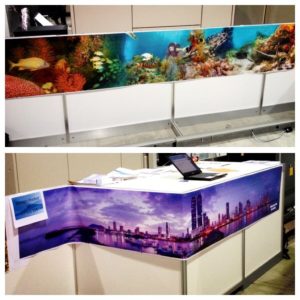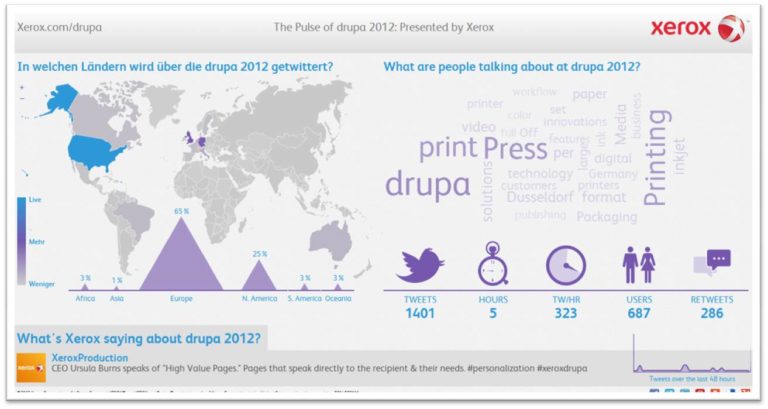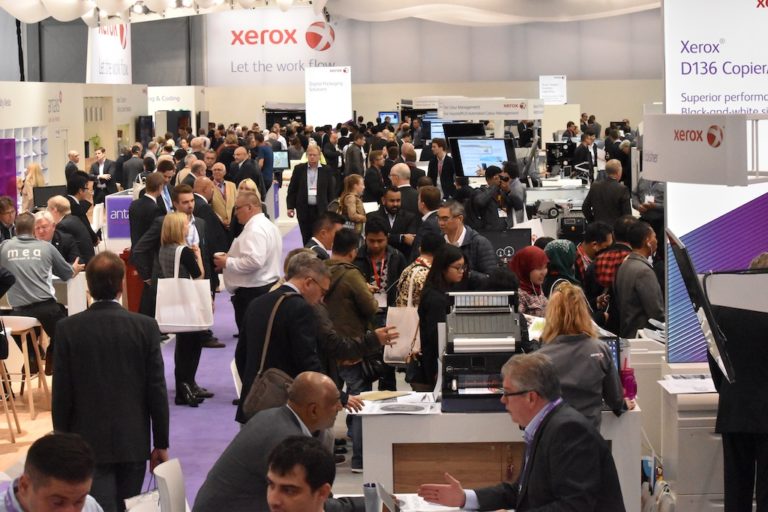Written by Jo Oliphant
Manager, Continuous Feed Europe, Xerox Corporation
Let’s take a moment to recap Hunkeler Innovationdays (HID), which recently took place in Lucerne, Switzerland. As trade shows go, this one rewrites all the rules typically followed and that’s probably because the host of the show is a vendor themselves; Hunkeler AG. My experiences with trade shows is that typically everyone wants to try and be bigger than everyone else, which has resulted in some elaborate and elegant stand designs, some of which don’t actually work effectively! Inevitably, the trade show venues have expensive food and drink for sale and there is a lot of walking to do. HID levels all of that. One hall, food and drink is supplied, the big vendors all have the same floor space and there are strict limits on how high (and therefore how big) everything is. The result? A more “industrial” approach to stand design. The best part of HID is the attendees: almost all are decision makers or key influencers and that calibre of attendee is reflected in the depth of conversations taking place.
Let’s take a look at what Xerox had to say at HID 2013.

At Hunkeler 2011, Xerox announced the CiPress 500 Production Inkjet System. Hunkeler 2013 saw the introduction of the Single Engine Duplex (SED) variant, extending the capability of the press to customers who either do not have the volume or the space to merit a Twin Engine Duplex (TED) system but still want to take advantage of printing vibrant colours on commodity offset stocks with strong process controls, a very powerful FreeFlow Print Server and strong environmental credentials (everyone wants this attribute, but doesn’t want to have to pay extra for it).
This new variant offers customers an additional growth path and also the capability of additional resilience for customers with TED installations. Some customers may start with a SED and as volumes grow can upgrade to a second SED and configure it to run either as two separate SED’s or one TED…meaning if one system requires maintenance then the other engine can be configured to run on its own, maintaining some level of productivity. Secondly, if a customer has a very short turnaround time on a job but has a larger job running at the same time, then it’s entirely feasible to run both SED’s with different jobs in parallel.
The CiPress platform is showing itself to be extremely capable in respect of its media handling capabilities. Some 30+ different applications were on show for customers to take away, including live work from a German CiPress customer; CWN Druck. This live work included children’s customised catalogues with a digital outer shell and offset printed contents, the digital shell from the Bon Prix catalogue (Bon Prix are part of the very large Otto Group) and tool catalogues on 40gsm paper. In addition to these there were also postcards on 9pt (220gsm) stock, some books on different plain papers and the real “wow” application of a very heavy coverage flyer printed on 29gsm stock. This super light stock is bible paper and CiPress is the only inkjet capable of printing onto this weight of stock, the only other way of printing this is to use an offset press.
Xerox previewed a new product called the Color 8250 Production Press attracting a lot of customer interest. This is an 8,250 full colour A4 sheets per hour cut sheet printer intended for transactional or direct mail volumes between 1 and 3 million A4’s per month.
The 8250 prints on plain uncoated papers and offers more of a business colour quality than graphic arts quality colour and better fits what might typically be expected on transactional, direct mail and trans-promo applications. It is powered by the FreeFlow Print Server as available on every other Xerox Production Press and is expected to ship in Europe early in Quarter 3 2013.
Xerox also reinforced the messaging on workflow and had GMC , XMPie and Solimar Systems all demonstrating how their workflows can elegantly connect different customers business requirements to ensure optimised presentation of their information for a variety of different output platforms. In addition to the workflow and the print platforms, Xerox continued to reinforce the story on business development; an area which many companies take advantage of from Xerox.
Did you attend HID 2013? What did you think? Did you see anything that made you say “wow”?
Interested in more topics similar to Hunkeler and Inkjet technology? You may like:
- What the Impika Acquisition Means for Xerox and our Customers
- Overall Equipment Efficiency (OEE)
- Newspapers: Sustainable Business Model or Yesterday’s News
- Printed Customer Communications – Marketing Opportunity or Inconvenience?
- Can Digital, Inkjet and Offset Production Printing Coexist?
- Is Digital Printing Killing Offset?


